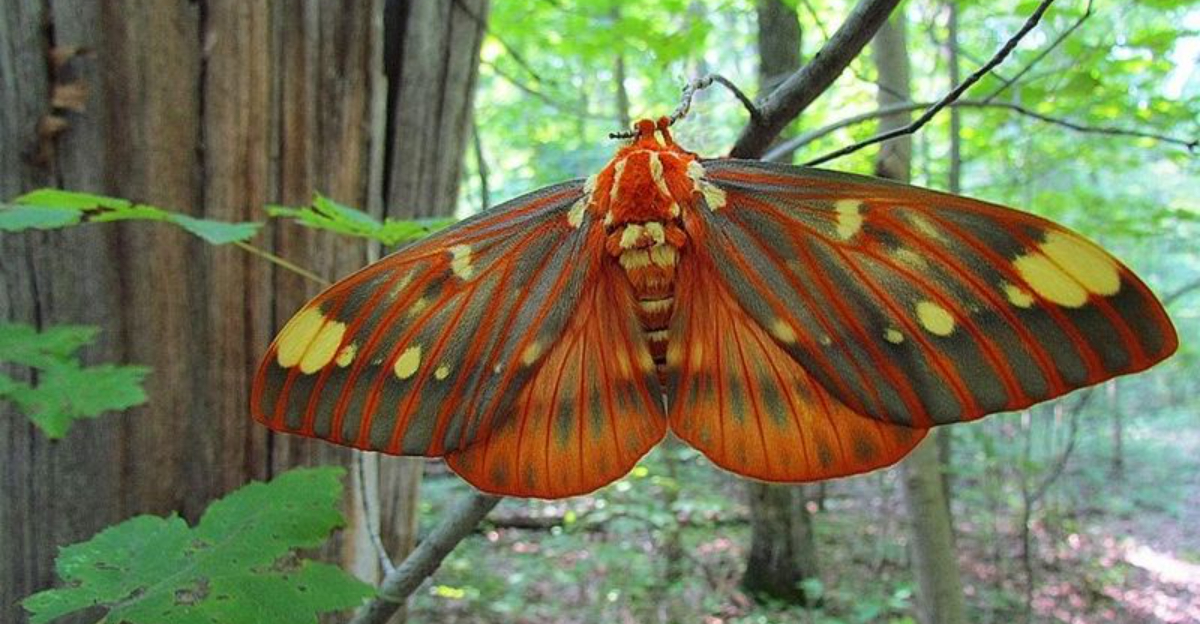Moths are often overshadowed by their more celebrated cousins, butterflies. However, these night-time fliers are equally captivating and display a range of mesmerizing patterns and colors.
Today we will explore some of the most beautiful moths that showcase nature’s artistic prowess. From intricate wing designs to vibrant hues, these moths are a testament to the awe-inspiring diversity found in the natural world.
Let’s delve into the enchanting world of moths.
1. Luna Moth
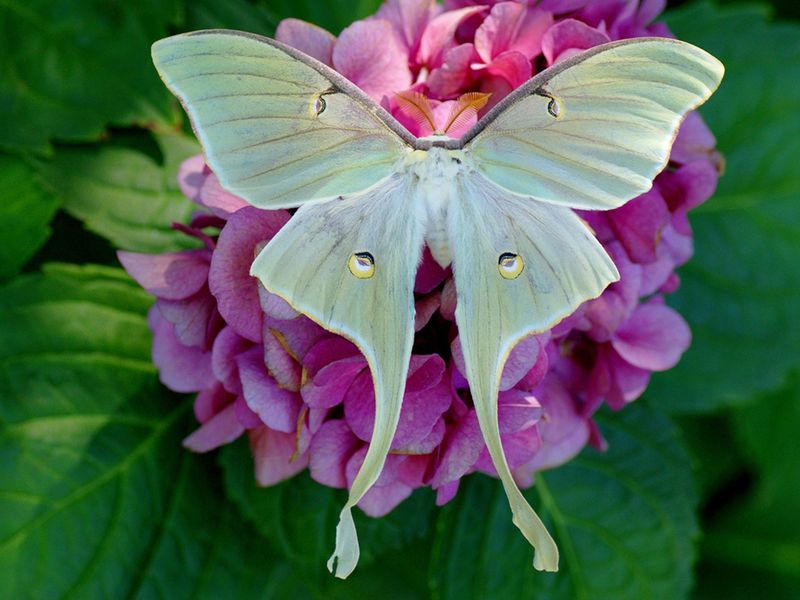
The Luna Moth is one of the most recognizable and beloved moths due to its stunning appearance and ethereal presence.
Its light green wings are delicately edged with a hint of purple, creating a soft, pastel-like effect that is both soothing and mesmerizing. The wingspan of the Luna Moth can reach up to four and a half inches, making it one of the larger moths in North America.
One of the most intriguing features of the Luna Moth is its long, trailing tail streamers that extend gracefully from its hindwings.
These tails are not just for show; they serve an important purpose in the moth’s survival. The tails help to confuse the echolocation of predatory bats, giving the Luna Moth a better chance at evading capture.
Despite its beauty, the Luna Moth has a short lifespan, living only about a week as an adult. During this time, it does not eat, having no functional mouthparts.
Its sole purpose in this stage is to mate and lay eggs to ensure the continuation of its species. This transient beauty adds a poignant layer to the Luna Moth’s charm, reminding us of the fleeting nature of life.
2. Atlas Moth

The Atlas Moth is a true giant of the insect world, boasting one of the largest wingspans of any moth or butterfly, measuring up to ten inches.
Found primarily in the tropical and subtropical forests of Southeast Asia, the Atlas Moth is a striking sight with its vibrant colors and massive size.
The moth’s wings are adorned with a mosaic of orange, brown, and red hues, intricately patterned to resemble the head of a snake.
This unique adaptation serves as a deterrent to predators, making the Atlas Moth less likely to be eaten. The tips of its forewings even curl to mimic a snake’s head, enhancing its chances of survival in the wild.
Despite its formidable appearance, the Atlas Moth is entirely harmless. Like many moths, it lacks a feeding mechanism as an adult, relying solely on the energy stored from its larval stage to sustain itself during its short adult life, which lasts just a few days.
This brief existence, coupled with its awe-inspiring size and beauty, makes the Atlas Moth a truly remarkable creature to behold.
3. Cecropia Moth
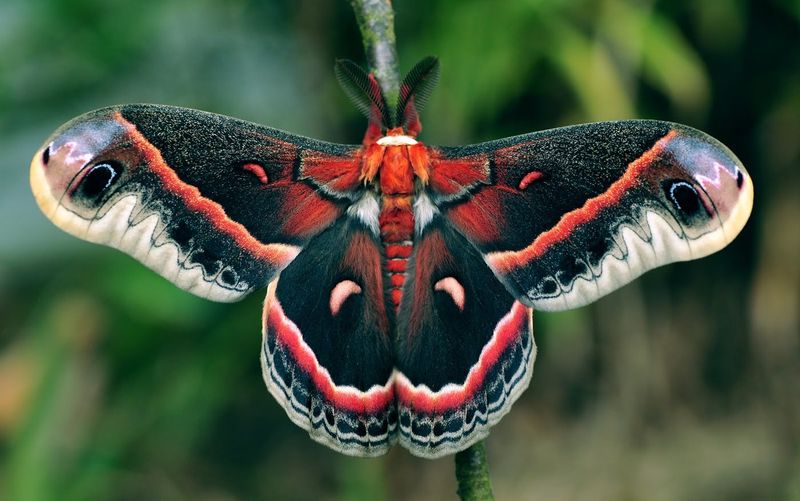
This giant is North America’s largest native moth, with a wingspan that can reach up to six inches.
Its vibrant colors and bold patterns make it a standout among the moth family. With a predominantly red and brown body, the Cecropia Moth features striking white bands and spots that add to its dramatic appearance.
This nocturnal flier is often spotted in wooded areas and is known for its impressive larval stage as well. Cecropia caterpillars are large and colorful, with a bright green body adorned with tubercles of various colors.
These caterpillars spend months feeding on the leaves of host plants, storing energy for their transformation into majestic moths.
In its adult form, the Cecropia Moth does not eat, similar to many other moth species. Its primary focus is on reproduction, with females emitting pheromones to attract mates from miles away.
This dedication to perpetuating the species is a testament to the moth’s role in the ecosystem, contributing to the rich biodiversity of its habitat.
4. Rosy Maple Moth
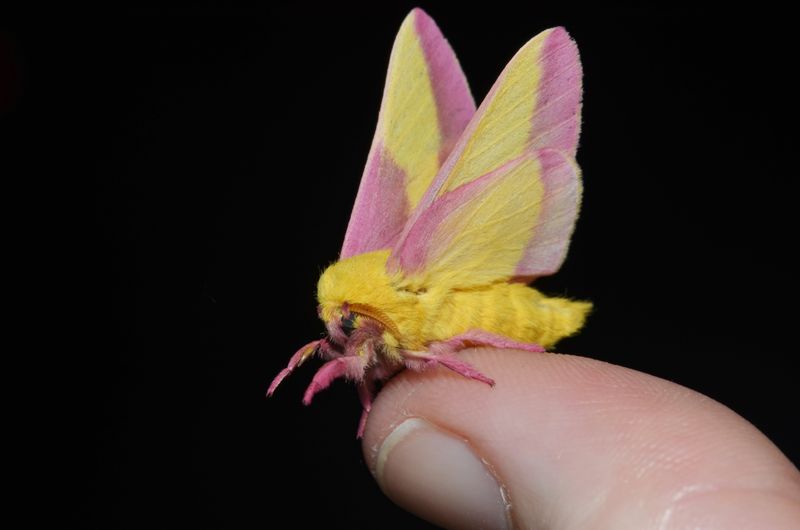
The Rosy Maple Moth is a delightful sight for anyone lucky enough to encounter it. With its bright pink and yellow wings, it almost looks like a flying piece of candy. This small moth is found across North America, typically residing in deciduous forests where maple trees are abundant, as its name suggests.
The vibrant coloration of the Rosy Maple Moth makes it easily recognizable. Its wings are a delicate mix of pink and yellow, with the pink often forming a distinct band across the wings.
This cheerful color combination is not only eye-catching but also acts as a form of camouflage among the colorful blooms and leaves of its habitat.
Despite its vivid appearance, the Rosy Maple Moth is a master of disguise when resting on a maple tree. Its colors blend seamlessly with the tree’s foliage, helping it avoid predators.
The Rosy Maple Moth is a testament to the beauty and adaptability of moths, showcasing how these creatures can thrive in their natural environment through unique adaptations.
5. Madagascan Sunset Moth
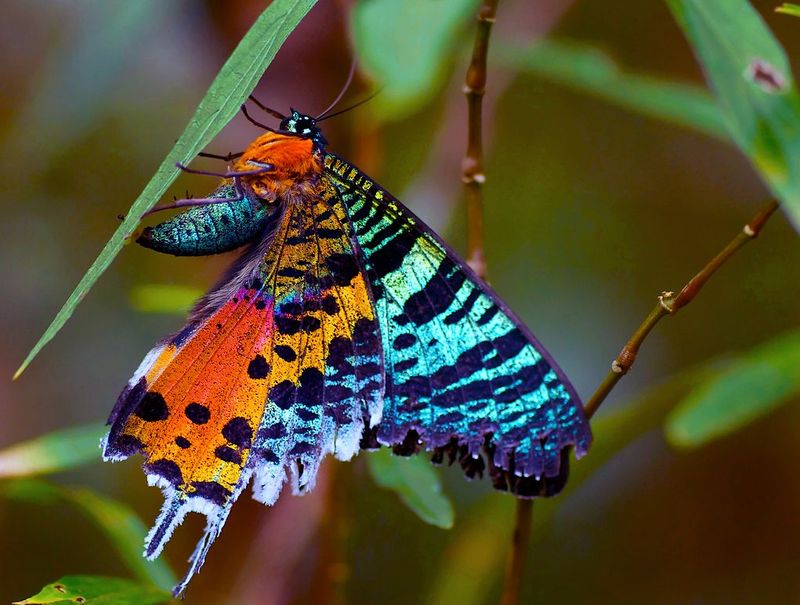
Considered one of the most beautiful moths in the world, the Madagascan Sunset Moth is a spectacular sight.
Unlike typical moths, this species is active during the day, flaunting its vivid colors in the sunlight. Its wings are adorned with iridescent greens, blues, and oranges, creating a dazzling display that resembles a sunset, hence its name.
Found exclusively on the island of Madagascar, this moth has evolved to be a master of mimicry. Its vibrant colors are a warning to potential predators about its toxicity, which it acquires through the plants it consumes as a caterpillar.
This defense mechanism makes it less likely to be eaten, allowing it to bask in the sun with minimal threat.
The Madagascan Sunset Moth’s beauty and unique lifestyle have made it a subject of fascination for entomologists and nature enthusiasts alike. Its ability to thrive in a specific ecological niche highlights the intricate balance of nature and the importance of preserving biodiversity.
6. Regal Moth

The Regal Moth, also known as the Royal Walnut Moth, is an impressive creature with a commanding presence. With a wingspan of up to six inches, it is one of the largest moths in North America.
Its wings are a rich blend of orange and cream, with a series of intricate patterns that give it a regal appearance worthy of its name.
The Regal Moth’s caterpillar, known as the Hickory Horned Devil, is equally remarkable. This caterpillar is one of the largest in North America, with a spiky, fearsome appearance that deters potential predators.
The adult Regal Moth does not feed, living only for a short time to mate and lay eggs. Its striking colors and patterns are thought to play a role in its mating rituals, attracting partners amid the dense foliage of its forest habitat.
The Regal Moth’s life cycle is a captivating example of nature’s continuous cycle of transformation and renewal.
7. Comet Moth

Native to the rainforests of Madagascar, this moth is an extraordinary sight with its long, flowing tail streamers and vivid coloration.
Its wings are a brilliant yellow, accented with eye spots that deter predators by mimicking the eyes of larger animals. These features make the Comet Moth one of the most visually striking moths in the world.
The tail streamers of the Comet Moth can extend several inches beyond its wings, creating an elegant, comet-like silhouette as it flutters through the air. This adaptation not only adds to its beauty but also aids in its survival by confusing predatory bats in flight.
The Comet Moth, like many other moth species, has a brief adult life span, during which time it focuses solely on reproduction.
Its enchanting appearance and unique adaptations are a testament to the incredible diversity of life found on the island of Madagascar, highlighting the importance of conservation efforts to protect such unique species.
8. Emperor Moth
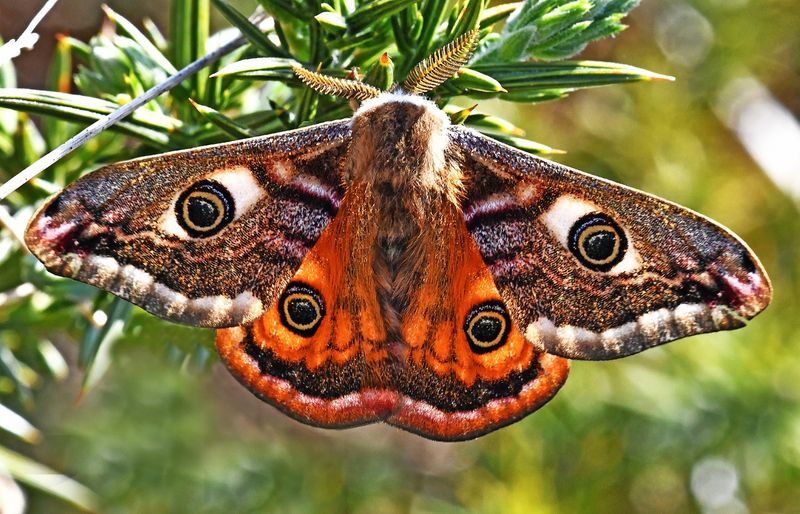
Found across Europe and parts of Africa, this moth is known for its beautiful eye spots that serve as a defense mechanism against predators. These spots resemble the eyes of an owl, deterring birds and other threats from attacking.
With a wingspan of up to three inches, the Emperor Moth is not the largest moth, but it is certainly one of the most striking. Its wings are a blend of orange, brown, and cream, with the distinctive eye spots adding to its allure.
The moth’s colors and patterns vary slightly depending on its geographical location, showcasing nature’s adaptability.
The Emperor Moth’s caterpillar is equally fascinating, with a bright green body adorned with black bands and yellow spots.
This larval stage is crucial for storing energy, allowing the moth to emerge and fulfill its lifecycle. The Emperor Moth’s stunning appearance and intriguing life stages make it a true marvel of nature’s artistry.
9. Garden Tiger Moth

This striking moth is found across Europe, North America, and parts of Asia, often inhabiting meadows and gardens where it can easily blend in with its surroundings.
The Garden Tiger Moth’s wings are a vivid orange, adorned with bold black spots and stripes that make it easily recognizable. This dramatic coloration serves as a warning to predators about the moth’s toxicity, which it acquires from the alkaloid-rich plants it consumes as a caterpillar.
The moth’s larval stage, known as the woolly bear caterpillar, is equally distinctive. Covered in bristly hairs, the caterpillar is well-equipped to deter predators while it feeds and grows.
This stage is essential for the moth’s development, as it accumulates the energy needed to transform into the striking adult moth. The Garden Tiger Moth’s life cycle and vibrant appearance emphasize the intricate connections between species and their environments.

